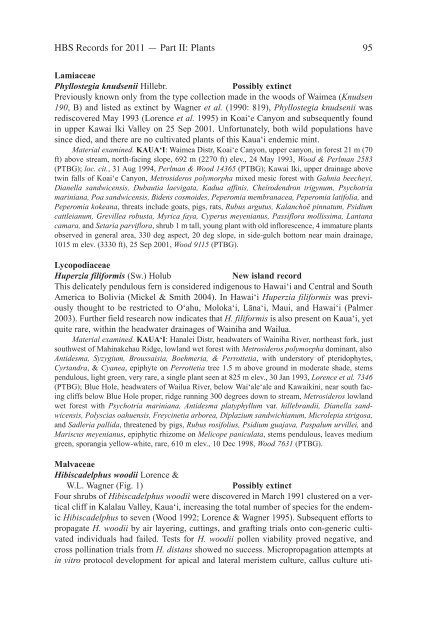OCCASIONAL PAPERS - Hawaii Biological Survey - Bishop Museum
OCCASIONAL PAPERS - Hawaii Biological Survey - Bishop Museum
OCCASIONAL PAPERS - Hawaii Biological Survey - Bishop Museum
You also want an ePaper? Increase the reach of your titles
YUMPU automatically turns print PDFs into web optimized ePapers that Google loves.
HBS Records for 2011 — Part II: Plants 95<br />
Lamiaceae<br />
Phyllostegia knudsenii Hillebr. Possibly extinct<br />
Previously known only from the type collection made in the woods of Waimea (Knudsen<br />
190, B) and listed as extinct by Wagner et al. (1990: 819), Phyllostegia knudsenii was<br />
rediscovered May 1993 (lorence et al. 1995) in Koai‘e canyon and subsequently found<br />
in upper Kawai Iki Valley on 25 Sep 2001. Unfortunately, both wild populations have<br />
since died, and there are no cultivated plants of this Kaua‘i endemic mint.<br />
Material examined. KAUA‘I: Waimea distr, Koai‘e canyon, upper canyon, in forest 21 m (70<br />
ft) above stream, north-facing slope, 692 m (2270 ft) elev., 24 May 1993, Wood & Perlman 2583<br />
(PTBG); loc. cit., 31 aug 1994, Perlman & Wood 14365 (PTBG); Kawai Iki, upper drainage above<br />
twin falls of Koai‘e canyon, Metrosideros polymorpha mixed mesic forest with Gahnia beecheyi,<br />
Dianella sandwicensis, Dubautia laevigata, Kadua affinis, Cheirodendron trigynum, Psychotria<br />
mariniana, Poa sandwicensis, Bidens cosmoides, Peperomia membranacea, Peperomia latifolia, and<br />
Peperomia kokeana, threats include goats, pigs, rats, Rubus argutus, Kalanchoë pinnatum, Psidium<br />
cattleianum, Grevillea robusta, Myrica faya, Cyperus meyenianus, Passiflora mollissima, Lantana<br />
camara, and Setaria parviflora, shrub 1 m tall, young plant with old inflorescence, 4 immature plants<br />
observed in general area, 330 deg aspect, 20 deg slope, in side-gulch bottom near main drainage,<br />
1015 m elev. (3330 ft), 25 Sep 2001, Wood 9115 (PTBG).<br />
Lycopodiaceae<br />
Huperzia filiformis (Sw.) Holub New island record<br />
This delicately pendulous fern is considered indigenous to Hawai‘i and central and South<br />
america to Bolivia (Mickel & Smith 2004). In Hawai‘i Huperzia filiformis was previously<br />
thought to be restricted to o‘ahu, Moloka‘i, lāna‘i, Maui, and Hawai‘i (Palmer<br />
2003). further field research now indicates that H. filiformis is also present on Kaua‘i, yet<br />
quite rare, within the headwater drainages of Wainiha and Wailua.<br />
Material examined. KAUA‘I: Hanalei distr, headwaters of Wainiha river, northeast fork, just<br />
southwest of Mahinakehau ridge, lowland wet forest with Metrosideros polymorpha dominant, also<br />
Antidesma, Syzygium, Broussaisia, Boehmeria, & Perrottetia, with understory of pteridophytes,<br />
Cyrtandra, & Cyanea, epiphyte on Perrottetia tree 1.5 m above ground in moderate shade, stems<br />
pendulous, light green, very rare, a single plant seen at 825 m elev., 30 Jan 1993, Lorence et al. 7346<br />
(PTBG); Blue Hole, headwaters of Wailua river, below Wai‘ale‘ale and Kawaikini, near south facing<br />
cliffs below Blue Hole proper, ridge running 300 degrees down to stream, Metrosideros lowland<br />
wet forest with Psychotria mariniana, Antidesma platyphyllum var. hillebrandii, Dianella sandwicensis,<br />
Polyscias oahuensis, Freycinetia arborea, Diplazium sandwichianum, Microlepia strigosa,<br />
and Sadleria pallida, threatened by pigs, Rubus rosifolius, Psidium guajava, Paspalum urvillei, and<br />
Mariscus meyenianus, epiphytic rhizome on Melicope paniculata, stems pendulous, leaves medium<br />
green, sporangia yellow-white, rare, 610 m elev., 10 dec 1998, Wood 7631 (PTBG).<br />
Malvaceae<br />
Hibiscadelphus woodii lorence &<br />
W.l. Wagner (fig. 1) Possibly extinct<br />
four shrubs of Hibiscadelphus woodii were discovered in March 1991 clustered on a vertical<br />
cliff in Kalalau Valley, Kaua‘i, increasing the total number of species for the endemic<br />
Hibiscadelphus to seven (Wood 1992; lorence & Wagner 1995). Subsequent efforts to<br />
propagate H. woodii by air layering, cuttings, and grafting trials onto con-generic cultivated<br />
individuals had failed. Tests for H. woodii pollen viability proved negative, and<br />
cross pollination trials from H. distans showed no success. Micropropagation attempts at<br />
in vitro protocol development for apical and lateral meristem culture, callus culture uti-

















